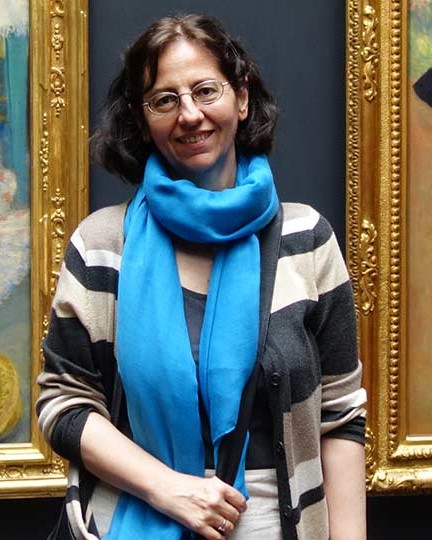Ágnes Pethő
ÁGNES PETHŐ is Professor of Film Studies at the Sapientia Hungarian University of Transylvania in Cluj-Napoca, Romania. As mentioned by Jens Schröter recently (2022), “Ágnes Pethő is also a ’founder of discursivity’. She is one of the central authors in the field of intermediality studies”. Her monograph, Cinema and Intermediality. The Passion for the In-Between (2011), which was revised and enlarged for the second edition in 2020, has become canonical reading on the subject. She is also the editor of a series of books on topics related to intermediality in cinema, such as Words and Images on the Screen (2008), Film in the Post-Media Age (2012), The Cinema of Sensations (2015), and Caught In-Between. Intermediality in Eastern European and Russian Cinema (2020).
She is the executive editor of the journal Acta Universitatis Sapientiae, Film and Media Studies (indexed and tracked for impact factor in the Web of Science – ESCI). Over the years she led research projects and organised many influential conferences in the field, such as Rethinking Intermediality in the Digital Age (2013), Figurations of Intermediately in Film (2014). The Real and the Intermedial (2015), Intermediality, in Contemporary Central and East European Cinema (2016), Intermediality Now: Remapping In-Betweenness (2018), Intermediality and World Cinema (2021), Uncanny Intermediality (2022) and Affective Intermediality. Cinema between Media, Sensation and Reality (2023), among others.
Uncanny Cinematicity:
Between the Aesthetics of Self-Reflexivity and the Politics of Impurity
Today’s media landscape is dominated by the diverse scales, forms and formats of digital images coexisting with the more traditional arts. At the same time, cinematic sensations have become a ubiquitous and familiar part of our everyday environment, of a world appearing as a moving spectacle in front of our eyes. Accordingly, the study of cinematic intermediality needs to remap its own terrain and redefine, or further refine its key concepts of “in-betweenness,” “passages” or “impurity.” It needs to include more subtle interactions and inflections within this new area of intermedial connections occurring between the old and new regimes of images, and thus it has to consider not only how “all arts flow through cinema,” as Alain Badiou wrote, but also, to specify the ways in which cinema (and post-cinema) becomes “a place of intrinsic indiscernibility between art and non-art.” In this presentation, I address this challenge (and engage with the keywords of the conference) by focusing therefore not on the intermediality of cinema but on films which foreground phenomenological encounters with the intermediality of cinematicity. Through brief case studies of a variety of moving image artworks (experimental, gallery film, feature film made for cinema), I will explore the uncanny cinematicity of images emerging from the juxtaposition of stasis and motion, immediacy and hypermediacy, the pre-cinematic impressions of audio-visual animation and the post-cinematic proliferation and relocation of cinematic experiences. Such a complex cinematicity is unravelled through different aesthetic strategies of self-reflexivity involving intermedial “dialogues” which all convey their particular politics of impurity by highlighting the intersections of art and life, and addressing key issues regarding our relationship with images.

Chiel Kattenbelt
CHIEL KATTENBELT is an emeritus associate professor in Media Comparison and Intermediality at the Department for Media and Culture Studies of Utrecht University. He is particularly interested in media, art and performance theory, aesthetics, semiotics, and phenomenology. One of his main interests in science, philosophy and art is thinking in triads.
He is affiliated as a researcher and dramaturg with the Belgian company CREW, which mainly specializes in creating performances and installations using technologies like virtual reality and motion capture. His publications include the co-editing of Intermediality in Theatre and Performance (2006) and Mapping Intermediality in Performance (2010). He is also a board member of the International Society for Intermedial Studies.

Theatre as playground for acting and staging | In the early 1990s, I defended that theater did not necessarily have to be understood as a dramatic art form. The dramatic mode of presentation is one of the ideal-typical variants in which theater manifests itself and was considered a historical norm only in a short period of its development since ancient times. Also, in my overconfidence as a younger academic, I put an end to the idea that acting is a matter of pretending. I also deliberately broke with a long tradition of thinking about theater as a composite art rather than an art form in itself. Instead, I argued that theater can be regarded as the art of the performer and as the paradigm of all arts. Based on my phenomenological and sign-pragmatic approach to the arts, my focus is not on representation but on aesthetic action as a specific form of communicative action with the aim of experientially exploring the scope and capacity of life experiences that are assumed to be shared. In this context it is important to point out the etymological relationship between experiment and experience. More specifically, my attention focuses on the performative aspects of aesthetic action, as manifested in worldmaking, staging, self-referencing and self-reflexing. These last two aspects are particularly relevant in my understanding of intermediality as a specific mode of performativity, causing with all its frictions, contrasts and disjunctions a creative force, and of theater functioning as a hypermedium, providing a stage for other media to be staged or rather a playground for other media to be played with and thus also to play with the senses of the experiencer. I will reconsider all the points mentioned here and relate them to the question of hybridity and impurity in the arts.

Paulo Filipe Monteiro
PAULO FILIPE MONTEIRO is a multidisciplinary Portuguese academic and artist, active in the fields of cinema, theatre, and writing – as a film director, scriptwriter, actor, playwright, and stage director. He also won the Revelation Award of Theatre Criticism. He studied scriptwriting in France, Italy and the United States and wrote 8 feature films so far. He was president of the Portuguese Association of Screenwriters and Dramaturgists (2002-2006). He directed the short film Amor Cego (2010, exhibited at the Museum of Modern Art in Rio de Janeiro, among other venues). He wrote and directed the features Zeus (2017, winner of 13 prizes) and Noites Claras (to be released in 2024) and, overall, he wrote and directed 16 theatre performances.
He is Full Professor in Communication, Arts and Culture at the New University of Lisbon, where he founded the MA in Performing Arts and is the coordinator of the branches of Performance Languages and Communication and Arts, of the PhD. degree in Communication Sciences of said university. As an artist, he is currently a dramaturgist of dance performances and researches the Pina Bausch method, since he attended an internship with her at Wuppertal in 2020. He directed the short screendance film Pas de Quoi (2020), exhibited in festivals in Portugal, USA, and Mexico, which won the Best Film prize in the InShadow festival in Portugal.
Dance and redundance in intermediality
- If the noun medium already designates something in between, which mediates, there must be reasons for the profuse redundance of saying intermedia, the in-betweens of in-betweens, what mediates mediations. Many aspects of this constellation have been intelligently analyzed, but it is worth reviewing some of the historical background to this dream of intermediality that has apparently come through, and find some questions still waiting to be answered. It is a fascinating history of illusions and disillusions.
2.
If theatre and cinema are the promised land for intermediality, screendance presents several challenges. I will discuss examples from two of my films, Pas de Quoi and Clear Nights. After these two projects, it became clear to me that hybridism is neither inevitable nor given. If we are to develop new languages, we’d better create the contexts and conditions for non-redundant in-betweeness.